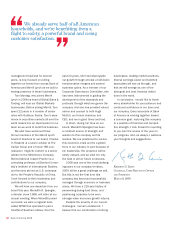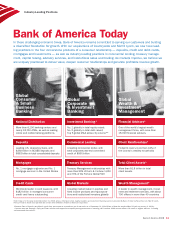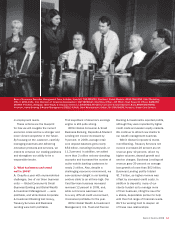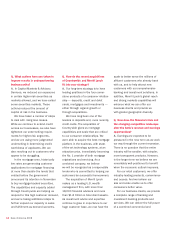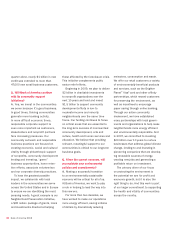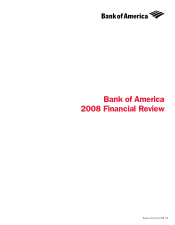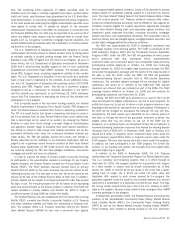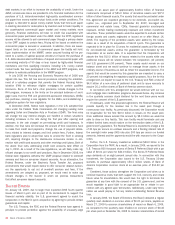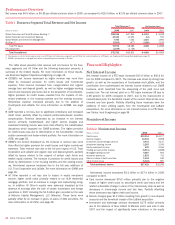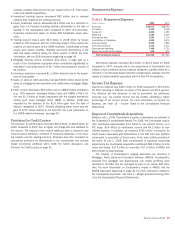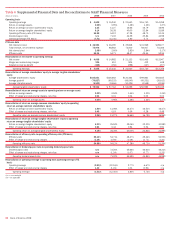Bank of America 2008 Annual Report Download - page 22
Download and view the complete annual report
Please find page 22 of the 2008 Bank of America annual report below. You can navigate through the pages in the report by either clicking on the pages listed below, or by using the keyword search tool below to find specific information within the annual report.home prices, rising unemployment, underemployment and tighter credit
conditions resulted in a higher level of bankruptcy filings during the year as
well as higher levels of delinquencies and losses in our consumer and
small business portfolios. Housing value declines, a slowdown in consumer
spending and the turmoil in the global financial markets also impacted our
commercial portfolios where we experienced higher levels of losses, partic-
ularly in the homebuilder sector of our commercial real estate portfolio.
Commercial criticized utilized exposures have also increased due to
broader-based economic pressures. For more information on credit quality,
see the Credit Risk Management discussion beginning on page 61.
Market dislocations throughout 2008, including the severe volatility,
illiquidity and credit dislocations that were experienced in the debt and
equity markets in the fourth quarter of 2008, adversely impacted our
CDOs and related subprime exposure as well as our other Capital Mar-
kets and Advisory Services (CMAS) exposures. Further, we have also
incurred losses associated with investments in certain equity securities
(e.g., Fannie Mae and Freddie Mac) and have incurred losses on the
buyback of ARS from our clients as discussed in the Recent Events dis-
cussion beginning on page 22. For more information on CDOs, the related
ongoing exposure and the impacts of the continuing market dislocations
(e.g., leveraged finance and CMBS writedowns), see the CMAS discussion
beginning on page 40.
The market dislocations have continued to impact certain SIVs and
have recently begun to impact senior debt issued by financial services
companies. During 2008, we provided additional support to certain cash
funds managed within GWIM by utilizing existing capital commitments and
purchasing certain investments from these funds. For more information on
our cash funds support, see the GWIM discussion beginning on page 45.
Market conditions also impacted the ratings of certain monolines,
which has adversely affected the pricing of certain municipal securities
and the liquidity of the short-term public finance markets. We have direct
and indirect exposure to monolines and, in certain situations, recognized
losses related to some of these exposures during 2008. For more
information related to our monoline exposure, see the Industry Concen-
trations discussion on page 76.
The above conditions, together with deterioration in the overall econo-
my, will continue to affect these and other global markets in which we do
business and will adversely impact our results in 2009. The degree of the
impact is dependent upon the duration and severity of such conditions.
Regulatory Initiatives
On February 27, 2009, the FDIC passed an interim rule that allows it to
charge banks a special assessment of 20 basis points (bps) on insured
deposits to replenish the deposit insurance fund. This special assess-
ment will be collected in the third quarter of 2009. Additionally, beginning
April 1, 2009, the FDIC will increase fees by approximately two bps on
insured deposits.
On October 3, 2008, the Emergency Economic Stabilization Act of
2008 (EESA) was signed into law. Pursuant to the EESA, the U.S. Treas-
ury created the Troubled Asset Relief Program (TARP) to, among other
things, invest in financial institutions through capital infusions and pur-
chase mortgages, mortgage-backed securities and certain other financial
instruments from financial institutions, in an aggregate amount up to
$700 billion, for the purpose of stabilizing and providing liquidity to the
U.S. financial markets.
Also pursuant to the EESA, on February 10, 2009 the U.S. Treasury
announced the creation of the Financial Stability Plan. This plan outlined
five key initiatives; a new Capital Assistance Program (CAP) to help
ensure that banking institutions have sufficient capital; the creation of a
new Public-Private Investment Fund on an initial scale of up to $500 bil-
lion to accelerate the removal of certain legacy assets from the balance
sheets of financial institutions; the expansion of the Term Asset-Backed
Securities Loan Facility (TALF) as discussed below; the extension of the
FDIC’s Temporary Liquidity Guarantee Program (TLGP) to October 31,
2009; and a new framework of governance and oversight related to the
use of funds of the Financial Stability Plan. As part of the CAP we will be
subject to stress testing. The objective of stress testing is an assess-
ment of losses that could occur under certain economic scenarios, includ-
ing economic conditions more severe than we currently anticipate. We
received the terms of the stress test on February 25, 2009 and are cur-
rently in the process of compiling the applicable information. The Federal
supervising agencies will conclude their stress testing as soon as possi-
ble but no later than April 30, 2009.
On October 14, 2008, in connection with the TARP Capital Purchase
Program, established as part of the EESA, the U.S. Treasury announced a
plan to invest up to $250 billion in certain eligible financial institutions in
the form of non-voting, senior preferred stock initially paying quarterly
dividends at a five percent annual rate. This amount was subsequently
increased to $350 billion. When the U.S. Treasury makes such preferred
investments in any company, it also receives 10-year warrants to acquire
common shares. In connection with the U.S. Treasury’s announcement,
we were identified as one of the nine financial institutions to participate
in the first $125 billion of U.S. Treasury investments.
As a result in October 2008, we issued to the U.S. Treasury
600 thousand shares of Bank of America Corporation Fixed Rate Cumu-
lative Perpetual Preferred Stock, Series N (Series N Preferred Stock) with a
par value of $0.01 per share for $15.0 billion. Also, as part of the initial
$125 billion investment and in connection with the Merrill Lynch & Co., Inc.
(Merrill Lynch) acquisition, in January 2009 we issued to the U.S. Treasury
400 thousand shares of Bank of America Corporation Fixed Rate Cumu-
lative Perpetual Preferred Stock, Series Q (Series Q Preferred Stock) with a
par value of $0.01 per share for $10.0 billion. The Series N and Series Q
Preferred Stock initially pay quarterly dividends at a five percent annual rate
that increases to nine percent after five years and have a call feature after
three years. In connection with these investments, we also issued to the
U.S. Treasury 10-year warrants to purchase approximately 121.8 million
shares of Bank of America Corporation common stock at an exercise price
of $30.79 per share. In addition, as discussed in Recent Events, in January
2009 as part of the Merrill Lynch acquisition we issued to the U.S. Treasury
an additional 800 thousand shares of Bank of America Corporation Fixed
Rate Cumulative Perpetual Preferred Stock, Series R (Series R Preferred
Stock) with a par value of $0.01 per share for $20.0 billion. The Series R
Preferred Stock pays dividends at an eight percent annual rate and may
only be redeemed after the Series N and Series Q Preferred Stock have
been redeemed. In connection with this investment, the Corporation also
issued to the U.S. Treasury 10-year warrants to purchase approximately
150.4 million shares of Bank of America Corporation common stock at an
exercise price of $13.30 per share.
Under the TARP Capital Purchase Program, dividend payments on, and
repurchases of our outstanding preferred and common stock are subject
to certain restrictions. For more information on these restrictions, see
Note 14 – Shareholders’ Equity and Earnings Per Common Share to the
Consolidated Financial Statements.
On November 25, 2008 the U.S. Treasury, using its authority under the
EESA, announced a plan to allocate $20 billion of TARP funds to the
Federal Reserve Bank of New York as credit protection for the newly estab-
lished TALF. The TALF is intended to assist the credit markets in accom-
modating the credit needs of consumers and small businesses by
facilitating the issuance of asset-backed securities and improving the
asset-backed securities markets. Under the TALF, the Federal Reserve
Bank of New York will lend up to $200 billion on a nonrecourse basis to
holders of newly issued AAA-rated asset-backed securities for a term of one
20
Bank of America 2008


